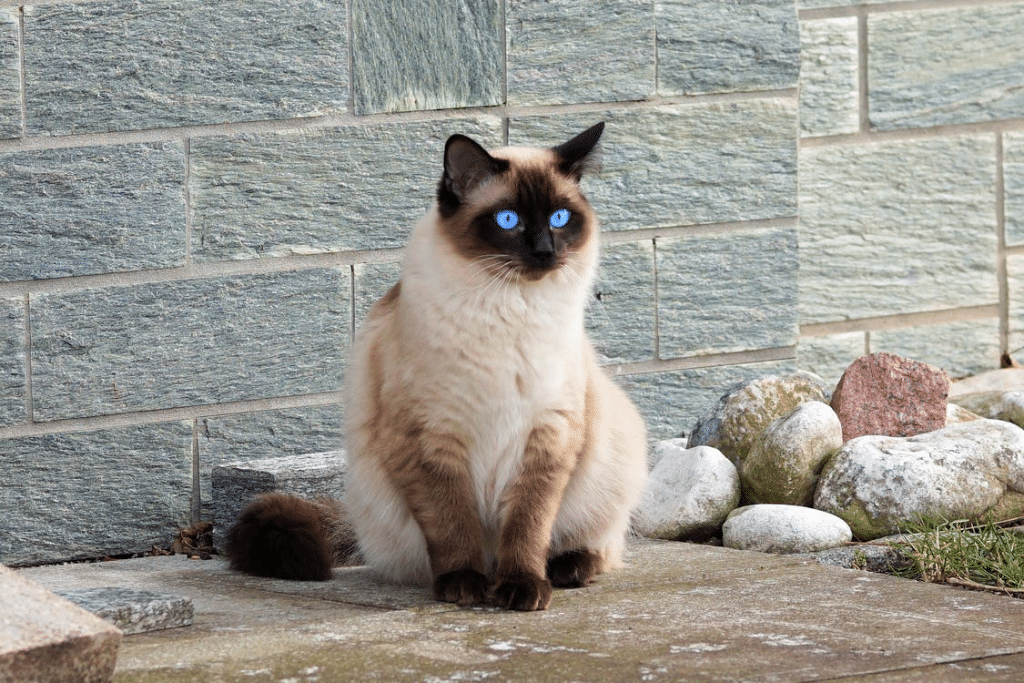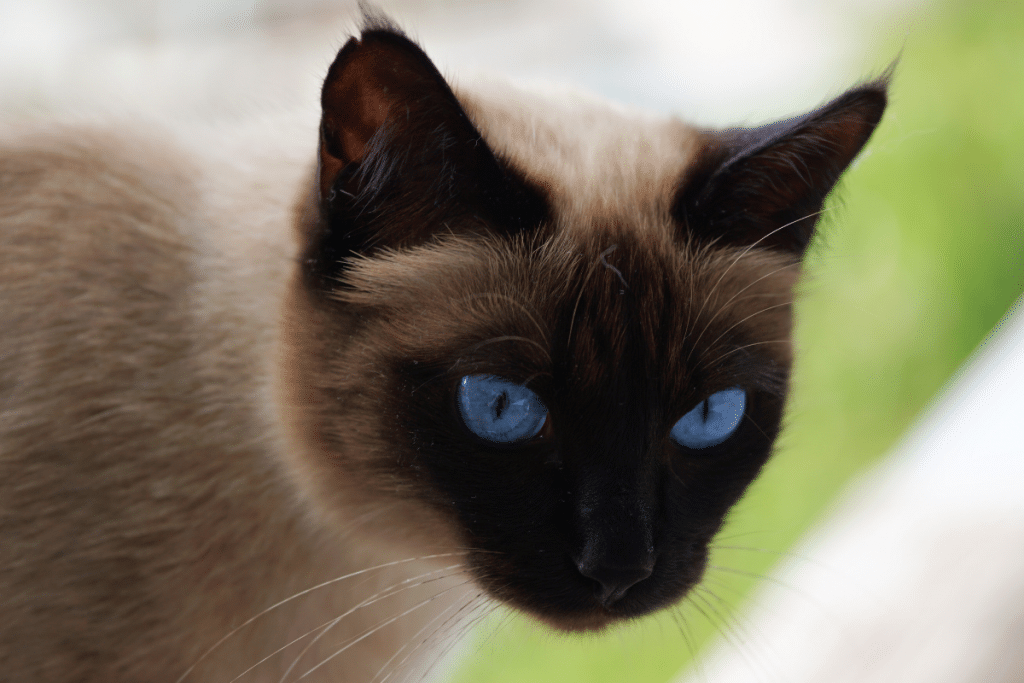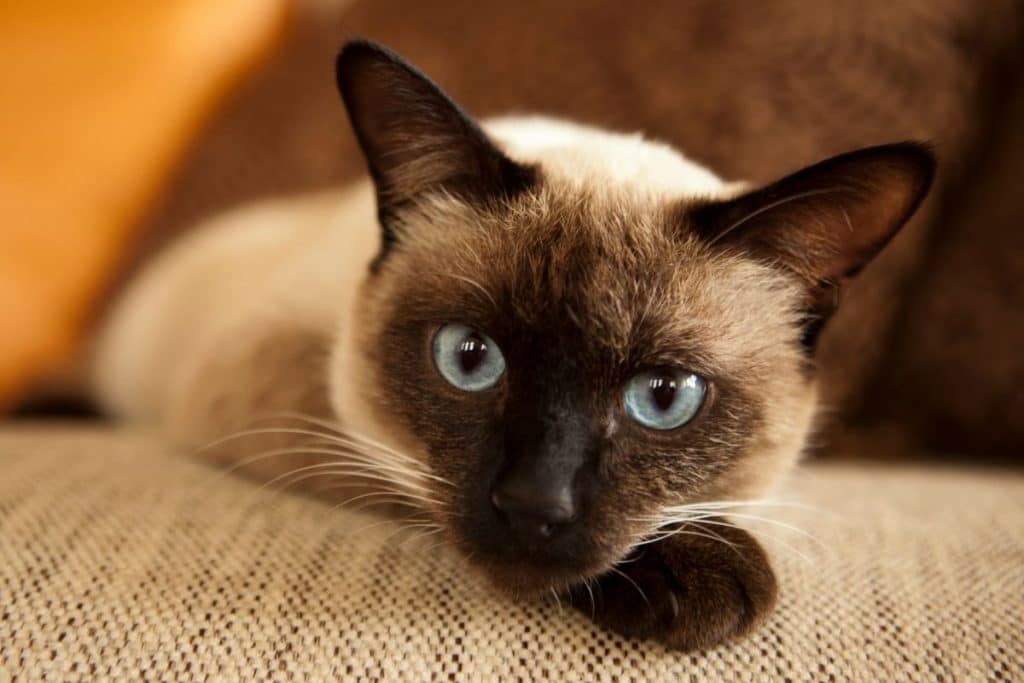Siamese cats are popular for their distinct appearance and unique personality. They are loving, affectionate, elegant, surprisingly intelligent, and are one of the most desirable cat breeds. If you are planning to bring a Siamese cat home, this post is for you.
It is a complete guide on having Siamese cats as a pet, covering almost everything you need to know about this incredibly amazing cat breed. Here, we share details of the history, appearance, and types of Siamese cats. Moreover, we discuss various aspects of the personality, training, and taking care of your Siamese cat. We will also share an insight into some of the health concerns that are common among Siamese cats. And lastly, we look at whether Siamese cats make a good pet and how well they get along with other pets.
So without further ado, let’s get started with this complete guide on having Siamese cats as pets.
1. History
The word “Siamese” comes from the ancient Thai language, which means “Moon diamond.” Historically, the breed is thought to have descended from an ancient cat that lived in the Siam Temple in Thailand, and hence it got its name. The Siamese cats are considered one of the oldest breeds of cats and have lived with humans for centuries. Some manuscripts dating back to the 14th century have referred to Siamese cats in a few poems.
Hence, the Siamese cat is one of the oldest cat breeds in the world, and while there are no specific timelines for the origin of these cats, the Siamese cats were brought to the U.S. in the 1800s as a gift from Thailand which was presented to the President’s wife. Later, because of its unique appearance and other desirable traits, the cat breed became a popular choice among commoners.
Today, Siamese cats are quite popular in most parts of the world. However, they are less common in Thailand now.
2. Appearance and Types of the Siamese Cat
The Siamese is an elegant breed with unique physical features that distinguishes it from other breeds. The Siamese cats usually have a lighter coat that contrasts with the darker face, ears, paws, and tail.Moreover, the strikingly blue eyes and slender body makes it easily recognizable.
While the Siamese cats are pure breeds, genetic mutation has drastically changed the breed’s appearance.
Siamese cats can be broadly categorized into two types,
- Traditional Siamese
- Modern Siamese.
The traditional variety includes the classic Siamese and traditional apple head Siamese cats. On the other hand, the modern variety of Siamese cats includes wedge head Siamese, dark-colored points, and light-colored points.
Let’s take a closer look at each type of Siamese cat.
2.1 Traditional Siamese Cats
The traditional Siamese cats have a distinct appearance with a medium-sized physique, large ears and nose, and well-formed eyes. However, some traditional Siamese cats can also be cross-eyed because of how they are bred.
Traditional Siamese cats such as apple head Siamese have an apple-shaped skull, bulkier body, and shorter tails. What distinguishes an apple head Siamese cat is its fluffy fur. The other traditional variety of Siamese cats, such as the classic Siamese, is different from apple head Siamese cats. While they have similar personalities, their leaner and longer bodies and longer tails set them apart from others. The classic Siamese cats were born in around the 1400s but gained official recognition recently.
2.2 Modern Siamese Cats
One of the popular modern varieties of the Siamese cats is the wedge head Siamese cat with a strikingly wedge-shaped head. The Wedge head Siamese cats have a leaner and more muscular body and long tails and legs, which make their appearance quite appealing.
However, their exaggerated wedge-shaped head has made them vulnerable to several health problems, including respiratory problems and pulmonary issues. Moreover, their narrow facial structure has also significantly increased the risk of some dental problems.
Other modern Siamese cats include dark-colored point Siamese and light-colored point Siamese cats such as Seal Point, Blue Point, Lilac Point, Chocolate Point, Red Point, and Cinnamon Point. Each type of modern Siamese cat varies in the shades of their fur, color of the eyes, nose, and paws.
3. The Siamese Cat’s Unique Personality
The Siamese cats have a unique personality. They are intelligent and curious, loving and affectionate, energetic and playful, and are among the most vocal cat breeds. However, there are a few undesirable aspects of the Siamese cat’s personality that you should be aware of.
Let’s take a closer look at each of the aspects of the Siamese cat’s personality so you can decide on having a Siamese cat as a pet.
3.1 Intelligent and Curious
The Siamese cats are intelligent and curious. They want to find out more about all the corners of your house so they can get comfortable with their new home quickly. Their curious nature can keep them engaged all day and can also put them in danger. Moreover, their higher intelligence and need to know allow them to get trained easily and learn several new things in a relatively shorter span of time.
3.2 Loving and Affectionate
Most pet parents who own a Siamese cat feel that this cat breed is quite expressive when showing love and affection to the owners. Siamese cats enjoy their owner’s company and would spend hours sitting on their lap and playing with them. And once they get used to their owner and their home, they are not very receptive to change.
Moreover, a Siamese cat is incredibly loyal to the owner, which is why it is often referred to as a “dog-like cat.”
And while a Siamese cat loves its owner and the family intensely, it can be a challenge for most pet parents. Siamese cats can easily feel neglected by their owner. Moreover, they have trouble staying at home alone. If left alone for a long time, Siamese cats are prone to depression. So while they are incredibly affectionate and loving, they can be too demanding for most pet owners.
3.3 Energetic and Playful
Another critical aspect of a Siamese cat’s personality is its energetic and playful nature. Since Siamese cats are curious and playful, they need constant stimulation to stay engaged. Thus, Siamese cats are a great pet for individuals who love to play with their pets. But if you are someone who doesn’t have time for hands-on activities but you still want a Siamese cat as your pet, it’s best to invest in a few toys such as puzzles, scratch pads, and other aids that can keep your playful feline busy while you are away.
3.4 Talkative
Siamese cats are quite talkative. They love to chatter with their pet parent as they play together. Moreover, Siamese cats are also quite expressive about their needs. They make a loud, unusual sound known as “meezer” whenever they are hungry, anxious, uncomfortable, or alone, and they continue to make this noise until you attend to their need. So if you are someone who doesn’t enjoy a lot of chatter and noise, then Siamese cats can be a tough choice for you.
4. Training Your Siamese Cat
The Siamese cats are one of the most intelligent cat breeds that you can easily train. You can train your Siamese cat to behave appropriately, how to use a litter box, do some tricks and even walk with a leash.
But before you get started with the real training, you should know that Siamese cats can easily understand the commands. However, they have a lot of energy, and they love to bond and play with their owner. So as you try to train them, it is common for your Siamese cat to get distracted easily. Hence, training your Siamese cat can be a long and time taking process.
As you start training your Siamese cat, know that the two most commonly used methods are most effective when used together. The training methods include
- Clicker Training
- Reward-Based Training
Clicker training is primarily used to avoid the undesirable behavior of your feline. The training method involves the use of a clicker that makes a sharp, clicking sound. Every time you see your Siamese cat involved in some dangerous or undesirable behavior, you press the clicker, and your feline hears the sharp sound. Over time, your Siamese cat will learn to correlate the loud noise with its inappropriate behavior and learn to refrain from such behaviors.
Primarily clicker training is more about training by using punishment, and the Siamese cats are quite sensitive; relying on punishment alone for training can have detrimental effects on their personality. Hence,you will need to complement the punishment-based training with a reward-based training system so your cat can learn quickly and more effectively.
A rewards-based training system is a way to appreciate positive behavior, where you, as a pet parent, can rely on can offer different rewards to your feline. When you use these two methods together, your Siamese cat will learn that certain behaviors will lead to punishment while avoiding other behaviors will be associated with rewards.
4.1 Tips and Tricks for Training Your Siamese Cats
Now that you know how you can train your Siamese cats, here are a few tips and tricks to make the job easier for you.
- Be consistent with rewards and punishment
- Offer desirable rewards
- Respond in time
- Respect your feline’s independence
- Be patient
5. Taking Care of Your Siamese Cat
When it comes to taking care of your Siamese cats, there are several aspects that you need to take care of. Let’s get started with your Siamese cat’s basic grooming and maintenance needs, followed by a detailed account of some of the health conditions common among Siamese cats.
5.1 Grooming Your Siamese Cats
Grooming your Siamese cat does not take a lot of time and effort because, like most shorthaired breeds, Siamese cats are great at taking care of themselves.
However, to maintain a shiny and healthy coat, you need to brush your Siamese cat at least once a week. Use a soft bristle brush for brushing your feline’s coat and move gradually in the direction of your cat’s hair growth. As you brush your cat’s fur, know that the head and belly are delicate areas, so you need to be extra gentle as you brush these parts of your feline’s body. Once you complete brushing, it is best to wipe your Siamese cat with a wet towel so you can collect all the dead hair. Know that Siamese cats do not enjoy spending time in the water so bathing is not a good idea for your Siamese cats.
You need to know that the Siamese cat’s coat is not as thick as other cat breeds and is less likely to shed. Moreover, the Siamese cat’s fur is hypo-allergenic, which means that a Siamese cat can be a great pet for you even if you have a fur allergy.
Unlike what most pet parents think of grooming, it is not limited to maintaining your cat’s coat. Grooming also involves cleaning your feline’s ears and trimming their nails as well.
Your Siamese cat has large ears, and perhaps they are the only part of your feline’s body that they can’t clean on their own. So as you brush your Siamese cat’s fur, check its ears as well. Cat’s ears are delicate, but they may require cleaning every week. Simply use a slightly wet toilet paper or cotton ball to brush the ears from behind the eyes all the way to the neck. Make sure you do it gently, as doing it too far can be painful for your pet. If you still find ear wax that you can’t remove, it’s best to consult your vet.
Another critical aspect of grooming your Siamese cat is trimming the nails. You must trim your cat’s nails regularly so you can discourage them from damaging your furniture and other household items. It’s a good idea to trim your Siamese cat’s nails a few times a month. Typically, your cat will need nail trimming at least twice a month.
While trimming can be a challenging task for most pet parents, it’s not always dangerous. All you need to do is to comfortably put your cat on your lap, squeeze their paws on the pad, so the claws pop out, and use a clipper at an angle of 45oon the nail. In case you cut too deep and your cat’s paws bleed, add some powder on the paw as it helps clot the bleeding.
And if you are one of those pet parents who dread trimming your feline’s nails, you can try seeking professional assistance for your cat’s grooming.
5.2 Feeding Your Siamese Cat
Apart from grooming your Siamese cat, another integral aspect of taking care of your feline is feeding it. You would already know that the Siamese cats have triangular heads, and the jaw constricts the space in their oral cavity. As a result, it is easier for them to swallow dry food. While they can eat food as a whole, chewing food can be a challenge for your Siamese cat. Moreover, chewable food tends to stick between the teeth, and if you don’t take proper care of your feline’s oral hygiene, it can lead to several diseases of teeth and gums. Therefore it is recommended that you choose wholesome and nutritious dry food for your Siamese cats that are easy to swallow.
Moreover, from a very young age, train your Siamese kitten to eat at the same time of the day. Once you establish a routine, it will be easier for you to feed them as they grow older. Furthermore, once you establish a routine, make sure you don’t change it often, or else your Siamese cat may avoid eating the same food altogether.
Along with a healthy and nutritious diet, your Siamese cats will need a lot of water as well. Since Siamese cats are playful and energetic, they will be running around the house most of the time. Moreover, they love to spend time outdoors, so it is natural for them to lose hydration. Thus you need to be particular about providing them enough water so they can stay hydrated. It’s best to give them access to freshwater. While your Siamese cat may be reluctant to drink water at first but with constant reinforcement, you can train them to drink water from time to time, so they can stay hydrated. Moreover, if you provide them with enough water every day, it will also help them maintain their kidney health.
6. Common Health Concerns Among Siamese Cat
The Siamese cats are one of the oldest purebred cats, and like other pure breeds of cats, they are also prone to several health conditions. While getting them from a genuine breeder can reduce the risk of diseases, but still, Siamese cats are prone to certain genetic diseases. Let’s look at some of the common health concerns among Siamese cats.
6.1 Gum and Mouth Diseases
Siamese cats are prone to developing certain diseases of the mouth and gums. Part of this health condition is related to the structure of their head and oral cavity. When the cat eats food, it tends to stick to the teeth, leading to a build-up of tartar along the gums and teeth. Over time, it causes inflammation of the gums and other supporting structures. If the problem is not addressed well in time, it can lead to the formation of small space pockets between the gums and teeth that can become the breeding ground for bacteria, which can lead to periodontal disease.
If the oral health condition is left untreated, the infection can spread from the tooth and gums to the entire body, including the liver and the kidney.
Therefore, as a pet parent, you need to take good care of your feline’s oral hygiene. Ensure you regularly brush your Siamese cat’s teeth and give them appropriate food that is not detrimental to their dental health. Moreover, don’t forget to schedule regular dental checkups for your feline.
6.2 Eye Problems
The Siamese cats are also prone to several eye problems, including nystagmus and progressive retinal atrophy. Nystagmus is an eye condition that can lead to the oscillation of the eye where your cat’s eye can start moving from up and down or from the right and left. While it is not exactly due to a disease of the eye, it could indicate something more dangerous, such as a cardiac or kidney-related problem.
As far as progressive retinal atrophy is concerned, it is an inherited disease that leads to progressive loss of vision and can also result in complete blindness if the problem is not addressed well in time.
6.3 Kidney Diseases
Another important organ of your Siamese cat that is commonly affected is the kidney. Since the kidneys are responsible for filtering waste products from the blood, any damage to the kidneys can have a negative impact on the overall health of the Siamese cats. Some of the common health concerns related to kidneys include infections, tumors, and blockages within the kidney and associated organs.
It is also possible that your Siamese cat’s kidney started to deteriorate over time and lead to chronic kidney disease. As soon as you notice any change in your pet’s volume of urine, it’s best to consult your vet so they can start the treatment right away. In some cases, your vet would flush the kidney using IV fluids, while other types of kidney disease may require some dietary changes along with medicines. However, the damage done to your Siamese cat’s kidney may be irreversible. Yet, with timely medical intervention, you can make sure that the condition does not deteriorate any further so your feline can live a normal life.
6.4 Congenital Heart Defects
Siamese cats are prone to several congenital heart defects, including Aortic stenosis, PDA, atrioventricular valve malformation. Congenital heart defects can be identified at a young age and show signs such as throbbing heartbeat and difficulty in breathing.
6.5 Vestibular Disease
Vestibular disease is a health condition related to the nerves of the inner ear. In most cases, vestibular disease is a genetic condition that can be identified through the cat’s loss of balance or tilted head. Some of the other symptoms of vestibular disease include dizziness and disorientation. While it is a minor health condition and often subsides on its own, it is best to consult your vet so you can address the concern before it gets worse.
6.6 Respiratory Tract Infections
Siamese cats are also prone to respiratory tract infections similar to influenza, a viral infection common among humans. Some Siamese cats can also suffer from inflammation in the trachea and nasal passage.
Moreover, Siamese cats are also prone to developing feline asthma, which can be a life-threatening condition. As soon as you notice that your Siamese cat is wheezing, coughing, or is experiencing difficulty in breathing, make sure you immediately consult your vet.
6.7 Cancer
Your Siamese cat may be more prone to certain types of cancers. While most cancers can be treated through surgical removal and chemotherapy, early detection plays an integral role in the success of the treatment.
Siamese cats are particularly prone to lymphoma, a specific type of cancer that leads to abnormal production of lymphocytes, which are a type of white blood cell.
Your Siamese cat may also be prone to separation anxiety and depression. While these are some of the common health concerns among Siamese cats, getting your pet from a genuine breeder can significantly reduce the risk of several genetic disorders common among Siamese cats.
7. How Well Do Siamese Cats Get Along with Other Pets?
Siamese cats have an immense amount of energy, and they love to play all the time. In fact, Siamese cats enjoy the company of most people and other pets as long as they are showered with love and care. Siamese cats typically get along well with other pets. However, they may not get along well with all pets. Here are a few pets that you should avoid adding to the family if you already have a Siamese cat at home.
- Old pets with little energy
- Pets that live in a cage and cannot run around with the Siamese cat
- Quiet cat breeds such as Persian cats and British Shorthair cats
On the other hand, your friendly and super-energetic Siamese cats can get along well with some pets. Some of the perfect pet partners for your Siamese cats include
- Other Siamese cats
- Puppies
- Other playful cat breeds including Siberian cats and Abyssian
8. Do Siamese Cats Make a Great Pet?
Now that you already know so much about Siamese cats, it’s time to find out the answer to the most important question, “Do Siamese cats make a great pet?”
The answer is “yes.”
Siamese cats are incredibly intelligent, playful, energetic, and loving. They love to enjoy the company of their owner and can spend hours playing with them. Moreover, they are friendly and caring towards children and most other pets and are easy to train. And not to forget they are strikingly appealing.
However, along with all these desirable traits, you must keep in mind that Siamese cats can easily get depressed, and leaving them alone can be a challenge. Moreover, they require a lot of physical activity, which might not always be possible for everyone given the time and schedule constraints. Furthermore, Siamese cats are chatty, love to talk, and are quite vocal about their needs. So if you are someone who cannot spend a lot of time playing with your feline or are more of a quiet fellow, then maybe Siamese cat is not for you.
9. Final Thoughts
Siamese cats have a long history, are one of the most popular cat breeds today, and they have all the right reasons for it.
They are friendly, loving, and loyal. They are intelligent, playful, and talkative.
In all, Siamese cats are family.
With this complete guide on having a Siamese cat as a pet, you can make the right choice for yourself.



